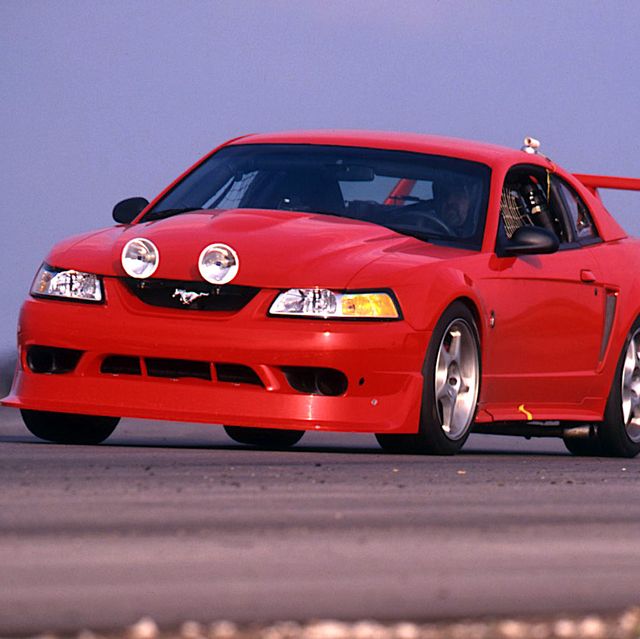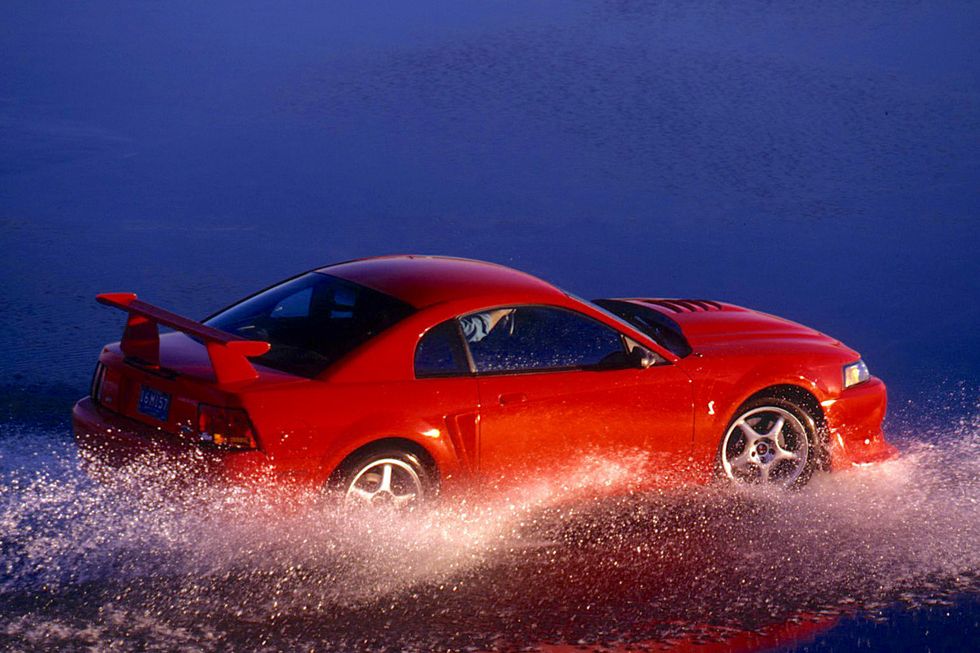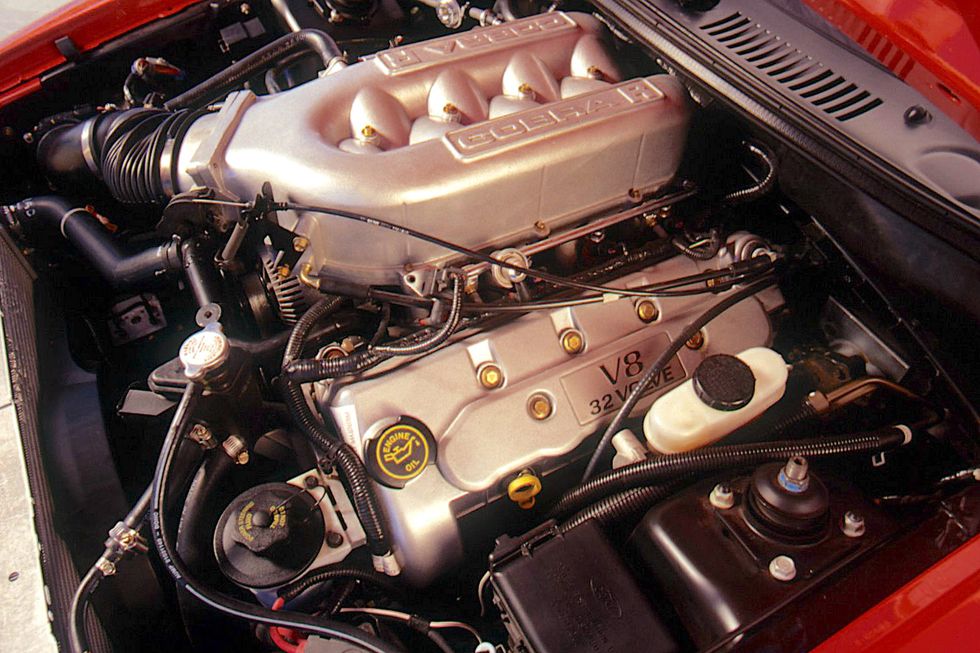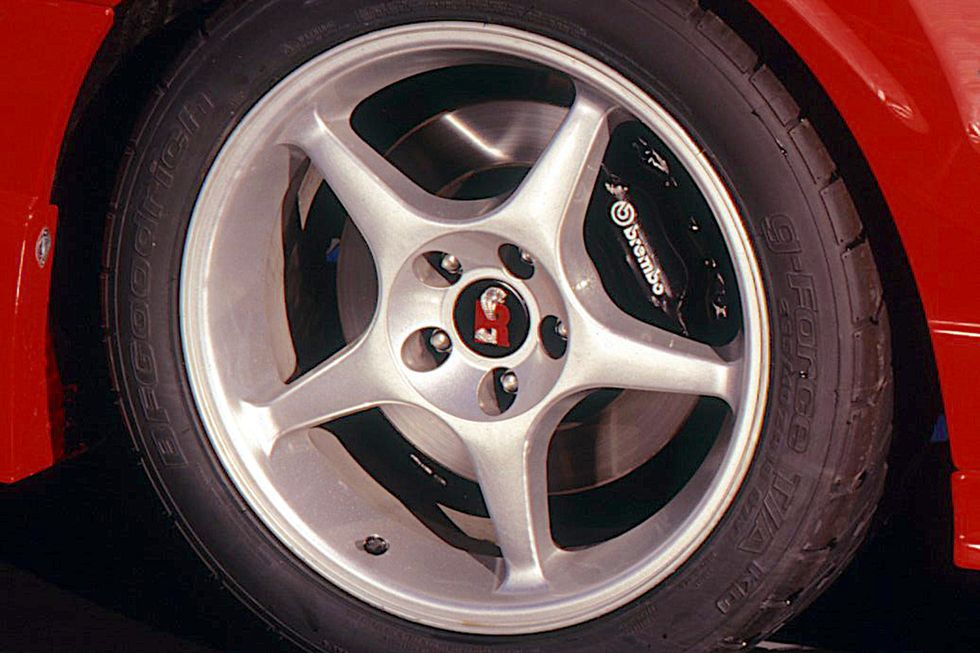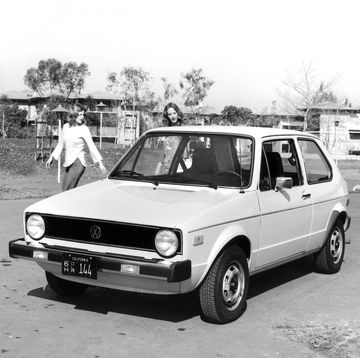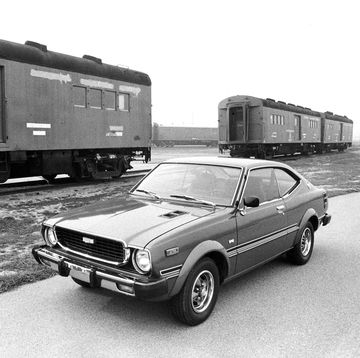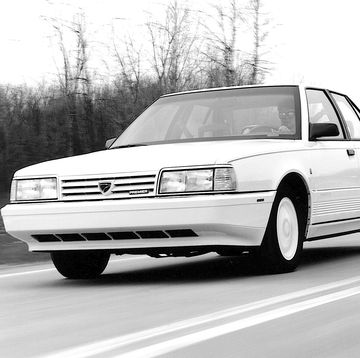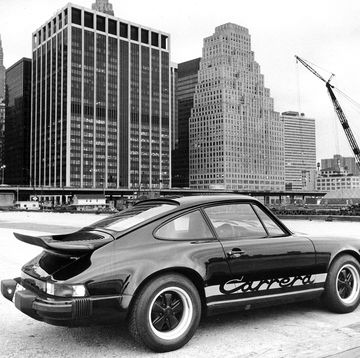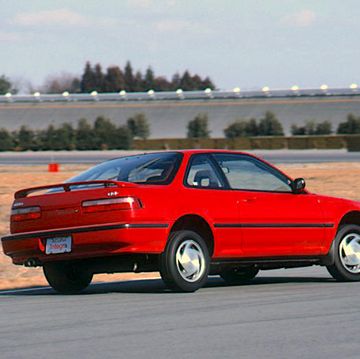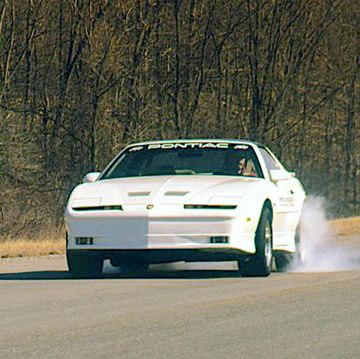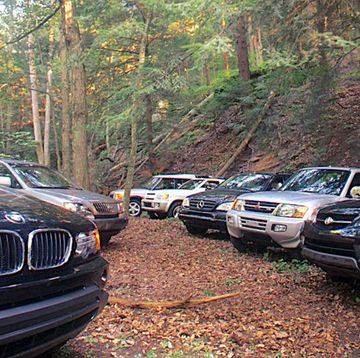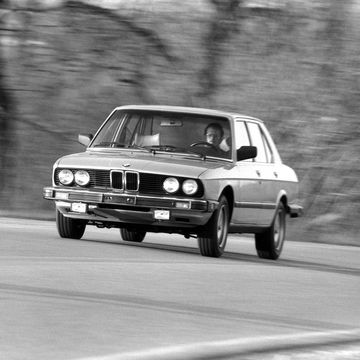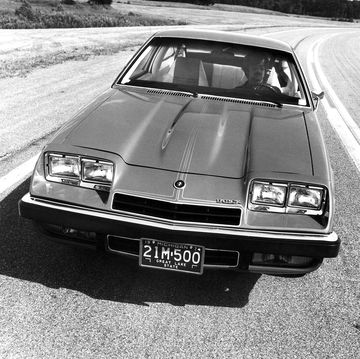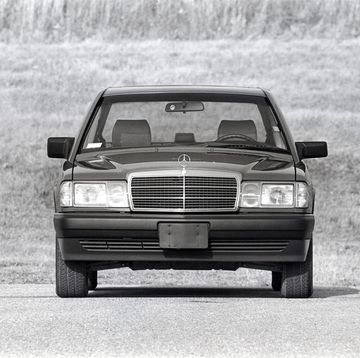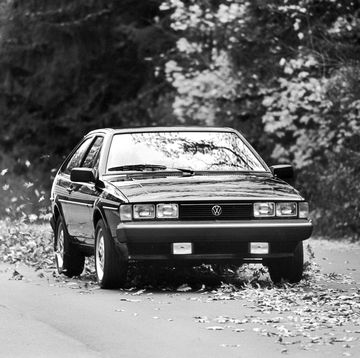From the April 2000 issue of Car and Driver.
"Nice, eh?" asks John Coletti, Ford Special Vehicle Engineering manager, who headed up the team that created the 2000 Ford SVT Mustang Cobra R we're driving on a rural Texas road that is not quite gravel, not quite blacktop.
We're loping along in fourth gear at maybe 50 mph, and the absolute lack of any sort of undercoating or sound deadening in the fender wells to muffle the thrown-up gravel makes it sound as though we're under attack by a battalion armed with Daisy BB guns.
Coletti—whom you met as the spiritual father of the big-block Mustang that battled the big-block Chevrolet Camaro built by Coletti's approximate bow-tie counterpart, Jon Moss, in our January 2000 cover story—likes that sound of gravel-in-the-wheel-wells because it suggests one thing: If it doesn't make the car go faster, it probably isn't part of the Cobra R. Sound deadening does not make the car go faster. It is likely Coletti required some engineer to make a case as to whether equipment such as windshield wipers and door locks was really necessary.
It was, he decided. Air conditioning was not. A stereo? Nope. Rear seats? Forget it.
The Cobra R is built to go, turn, and stop fast, evident from the statistics: a 175-mph (drag limited) top speed, a quarter-mile time of 13.2 seconds at 110 mph, 1.02 g's of grip on the skidpad, braking from 70 mph to 0 in 160 feet.
Fast cars are expensive, typically, and the Cobra R qualifies there, too: $55,845. SVT will build just 300 for model year 2000, with no present plans for a 2001 model. If your order hasn't already been accepted for delivery, which begins this month to SVT dealers selected through a lottery, most likely you're too late.
The 2000 Cobra R is the third such iteration. The 1993 Cobra R was a tentative, mildly successful step toward a very limited-edition performance Mustang, with just 109 built. Next came 250 copies of the 1995 Cobra R, a more fully realized effort; as tested in the April 1995 issue, our refrigerator-white cover car, with its 300-hp, 5.8-liter pushrod V-8, managed a top speed of 151 mph, quarter-mile performance of 14.0 seconds at 99 mph, 0.89 g on the skidpad, and 70-to-0-mph braking of 165 feet.
Excellent numbers even today. "We have a simple rule of thumb for when it's time to develop a new Cobra R," Coletti says. "First, when there's a need, and second, when the new one will be able to outshine the old one by far." The 2000 model does, at a price about $20,000 more than the 1995 Cobra R.
The exterior of the 2000 Cobra R differs more from the stock Mustang Cobra than the 1995 Cobra R did. The new version has a massive, functional (but nonadjustable) rear wing, a huge front spoiler, and an air splitter that mounts to the car's nose using Dzus fasteners. SVT quietly recommends mounting that splitter only for show or for road-race competition—the car is delivered with it unattached and wrapped in plastic—because the first time you get close to a curb you'll wipe out that splitter.
Beneath the body—painted any color you want as long as it's Performance Red, with a Dark Charcoal interior—the changes are massive. Inside the cockpit, there are nearly perfect Recaro buckets up front and, as noted, no rear seats. There are dual airbags, a tilting steering wheel, a 180-mph speedometer, and some power-operated features such as outside mirrors, windows, and locks, and a trunk release. The interior is basic, sure, but it doesn't look as bare-bones as you'd expect.
The B&M Ripper shifter connects to a Tremec T-56 six-speed manual transmission. Working our way forward, we find a beefy 11-inch single-disc clutch, an aluminum flywheel, and then the engine: a breathed-on, naturally aspirated 5.4-liter V-8 that pumps out 385 horsepower and 385 pound-feet of torque.
The standard Mustang Cobra has the 5.4-liter Triton's smaller cousin, the 4.6-liter V-8, which is rated at 320 hp. But regular readers may recall our shootout (August 1999) that pitted a 1999 Cobra convertible against a Pontiac Firebird Trans Am and a Camaro SS. We were disappointed in the performance of the Cobra, and when we showed SVT our test results, it did some reconnaissance work and found that some of the Cobra engines departed the factory with less than 320 horsepower, due mostly to an improperly finished intake and too-restrictive mufflers.
By admitting that shortcoming and seeking to fix the afflicted engines, Ford and SVT did the right thing but lost some credibility with fans and even became the subject of an as-yet-unresolved class-action suit. Given that unpleasant experience, we have little doubt that the Cobra R makes the claimed horsepower and torque.
How was this accomplished? By extensive modification, using a mix of parts-bin pieces, brand-new pieces, and exceptional aftermarket pieces. From the top, a cylindrical K&N air filter feeds a new, larger single-bore throttle body based on the Cobra's dual-bore unit and a two-piece intake manifold. The cylinder heads began as units designed for Ford's off-road truck racing program but are essentially brand-new—they increase peak airflow 25 percent over the heads on the 4.6-liter Cobra. The camshafts are similar to the Cobra's but have more aggressive opening and closing rates and substantially higher lift.
The flat-top aluminum pistons are similar to those found in the SVT Lightning pickup and allow for a 9.6:1 compression ratio. (Needless to say, premium gas is required.) Carrillo built the billet-steel connecting rods. The overall height of the iron-block 5.4-liter engine (it has the same bore as the 4.6-liter V-8, but the stroke is longer, resulting in a deck height that is 29 millimeters taller) required the development of new motor mounts and a new crossmember to lower the engine 12mm.
The tubular-steel exhaust manifolds fit into a Bassani X-pipe, which connects through standard Cobra catalytic converters, to Borla mufflers and tailpipes that exit out the side. The sound is throaty but never invasive.
Up front the suspension has modified MacPherson struts with gas-charged monotube Bilstein shocks, 800-pounds-per-inch Eibach springs, and a 28mm anti-roll bar. In the rear, the independent suspension that debuted on the current Cobra uses steel upper control arms, aluminum lower control arms, Bilstein twin-tube gas shocks, and 750-pound Eibach springs. There's a 26mm anti-roll bar. (By comparison, springs in the standard Cobra are rated at 500 pounds up front and 470 pounds in the rear.)
The 13-inch disc brakes up front are vented Brembos with aluminum calipers and Galpher racing pads. Cooling ducts lead from the front fascia, and there are carbon-fiber heat shields. The vented rear discs are 11.7-inchers, with a single-piston caliper and Akebono racing pads. Anti-lock brakes are standard.
And finally, the wheels are 9.5-by-18-inch five-spoke aluminum alloys wearing fat 265/40ZR-18 BFGoodrich g-Force KD radials that are made especially for the Cobra R. There is a full-size spare nestled next to a 21-gallon Fuel Safe fuel cell.
How does all this work? Rather spectacularly. We participated in a 24-hour endurance test of a Cobra R, which had few modifications aside from a full roll cage, and gave it maybe 90 minutes of flat-out flogging at the Texas Motorsports Ranch, a private road course located south of Fort Worth.
Handling is dead-solid predictable up to the considerable limits, and when those limits are reached, gentle oversteer suggests you back off a bit, but there is not a hint of tail-happiness. The brakes, as their size and pedigree suggest, are superb, with stunningly little fade even over extended periods of hard use.
The narrow-gated B&M shifter takes a little getting used to but has a sure execution once you do. Clutch-pedal action is surprisingly light. Power is always there, in every gear: The final-drive ratio is 3.55:1, compared with the standard Cobra's 3.27:1.
The steering is not quite as linear as we'd like, but it's precise. The BFG radials gave excellent wear, but once they heated up—it took about 20 minutes of full-tilt driving—they began to feel a bit greasy, and after 45 minutes, we had to adjust our driving style to compensate for some skating. Few races of the sort a Cobra R might see last longer than 20 minutes, so given that, we have no complaints about the tires.
By the end of the 24-hour session, the Cobra R was neither bloody nor bowed and appeared ready for another 24.
Perhaps the most commendable aspect of the Cobra R, though, is its polite road manners. Even with the stiff suspension, the ride, though plenty firm, is entirely tolerable. The powertrain never seems peaky or frantic. And those Recaro buckets: If you have to be stuck in a traffic jam, there is probably no better place to sit.
SVT no longer requires you to produce some sort of competition license—SCCA, NHRA, or other—to buy a Cobra R as it previously did. Still, we predict the 300 built this year will fall mostly into the hands of serious collectors, with some destined for the racetrack.
We hope even the collectors will, from time to time, put the Cobra R through its paces. Arguably the best production pony car ever built, it deserves some exercise.
Specifications
Specifications
2000 Ford SVT Mustang Cobra R
Vehicle Type: front-engine, rear-wheel-drive, 2-passenger, 2-door coupe
PRICE
Base/As Tested: $55,845/$55,845
ENGINE
DOHC 48-valve V-8, iron block and aluminum heads, port fuel injection
Displacement: 330 in3, 5409 cm3
Power: 385 hp @ 5700 rpm
Torque: 385 lb-ft @ 4500 rpm
TRANSMISSION
6-speed manual
CHASSIS
Suspension, F/R: control arms/control arms
Brakes, F/R: 13.0-in vented disc/11.7-in vented disc
Tires: BFGoodrich g-Force KD
265/40ZR-18
DIMENSIONS
Wheelbase: 101.3 in
Length: 183.5 in
Width: 73.1 in
Height: 52.2 in
Passenger Volume, F: 49 ft3
Trunk Volume: 11 ft3
Curb Weight: 3580 lb
C/D TEST RESULTS
60 mph: 4.7 sec
100 mph: 11.0 sec
1/4-Mile: 13.2 sec @ 110 mph
130 mph: 18.5 sec
150 mph: 29.0 sec
Rolling Start, 5–60 mph: 5.1 sec
Top Gear, 30–50 mph: 9.0 sec
Top Gear, 50–70 mph: 9.1 sec
Top Speed (drag ltd): 175 mph
Braking, 70–0 mph: 160 ft
Roadholding, 300-ft Skidpad: 1.02 g
EPA FUEL ECONOMY (EST)
City/Highway: 16/25 mpg
